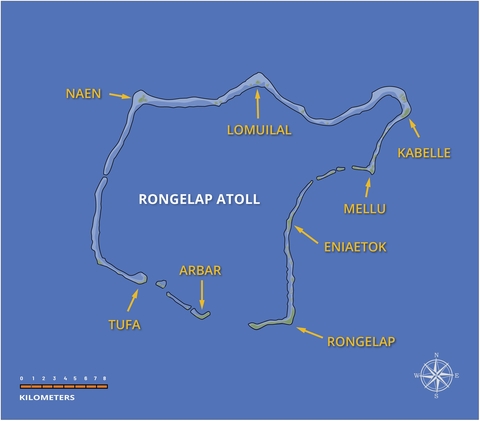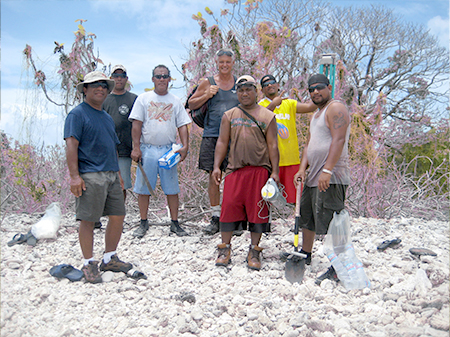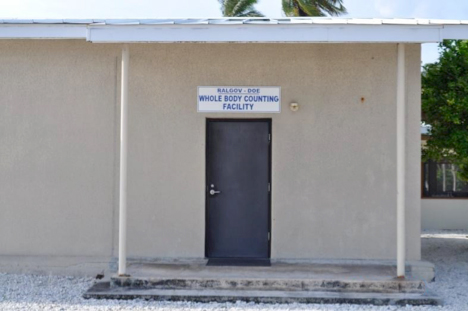Rongelap Atoll
THE HISTORY OF NUCLEAR TESTING ON RONGELAP ATOLL

Rongelap Atoll is one of 29 atolls and 5 islands in the north-equatorial Pacific Ocean that collectively form the Republic of the Marshall Islands (RMI). The atoll consists of about 61 low-lying islands occupying a combined land area of approximately 9 km2 surrounding a shallow water lagoon of around 1000 km2. The largest and most important island on the atoll is Rongelap Island. Rongelap Island is the ancestral homeland of a culturally and ethnically distinct group of Marshallese people that were accidentally exposed to “fresh” fallout contamination from the infamous CASTLE-Bravo test of 1 March 1954.
A total of 64 people living on Rongelap and neighboring Ailinginae Atoll at the time of the blast received significant exposure to fresh radioactive fallout contamination and had to be evacuated to Kwajalein Atoll for medical care and to avert further exposure. The Rongelap community spent the next 3 years living on Ejit Island on Majuro Atoll. They returned home to Rongelap in June 1957 only to enter a self-imposed exile during 1985 when it was revealed in Marshallese language reports that the atoll remained contaminated with long-lived fallout radionuclides. Since this time, the people of Rongelap have lived in temporary housing on Majetto Island at Kwajalein Atoll and endured many years of frustration in attempting to obtain assurances from the U.S. government that it would be safe for them to return home.
Through the Rongelap Resettlement Act, the United States Congress approved and continued a 1996 resettlement agreement between the United States and the Rongelap Atoll Local Government (RALGOV). As part of the 1996 resettlement agreement, a Phase I resettlement program was initiated in 1998. Under this agreement, scientists from the Lawrence Livermore National Laboratory were tasked with developing individual radiation protection monitoring programs for resettlement workers and to verify effectiveness of cleanup measures.

CLEANUP AND RESETTLEMENT OF RONGELAP ATOLL
Under the resettlement program, Rongelap Island now boasts a host of modern-day facilities. However, the status of the resettlement program through 2022 remains very uncertain. Approximately 50 new homes were built on the island during the early 2000s. The island was also equipped with a field station, various workshop buildings/garages, an electrical generation plant, a paved runway, paved roads, a Reverse Osmosis (RO) freshwater plant and storage tanks, a large concrete pier and beach bungalows. A whole-body count facility and an adjoining radioloigical support laboratory were also constructed on the island.
The remedial action plan adopted under the Rongelap Resettlement Program was based on recommendations developed by scientists from the Lawrence Livermore National Laboratory (LLNL). These procedures became known as the ‘combined option,’ which involves two separate strategies . The first activity reduces the external dose in the community-village areas of coral atolls, where people spend most of their time, by replacing contaminated surface soil with a layer of clean crushed coral fill.
This work was fully executed by local government contractors on Rongelap Island during the early 2000s and was found to be very successful. The use of coral fill (as sand and beach rubble) is a widely used and culturally acceptable practice to reduce the amount of dust in the air. Consequently, the addition of clean coral fill material in the community-village area on Rongelap also provides the benefit of reducing the resuspension of contaminated dust particles in the air that people breathe. Similarly, the addition of crushed coral reduces skin exposure to beta emitting contaminants in the soil, especially from strontium-90.
The second action was to reduce the ingestion dose that island residents could receive from consuming cesium-137 contained in locally grown foods. This is readily accomplished by adding potassium fertilizer to soil in agricultural areas. The addition of potassium fertilizer competitively blocks cesium-137 uptake into food plants such a coconut. Also, studies from long-term remediation experiment on Bikini Island show that a single application of potassium can be effective in reducing cesium-137 uptake in food plants for 15-20 years or longer. This work was only partially completed by the local government contractor on the north end of Rongelap Island.

WHOLE-BODY COUNTING AND PLUTONIUM URINALYSIS PROGRAMS ON RONGELAP
Many of the long-term resettlement workers living on Rongelap Island over the past 2 decades have acquired measurable quantities of internally deposited cesium-137 in their bodies. The yearly average annual effective dose rate from internally deposited cesium-137 has typically ranged from <0.01 to about 0.04 mSv per year. No resettlement workers have exceeded the annual dose criterion established by the national government for cleanup of radioactively contaminated sites of 0.15 mSv per year.
In general, the low-level of internally deposited cesium-137 observed in the resettlement workforce living on Rongelap support a decision to resettle. However, there are legitimate concerns about using the results of the existing whole-body counting program as a basis for showing compliance for full unrestricted resettlement of the atoll. By making direct comparisons between exposure to workers and the dose guidance established for cleanup and resettlement, we assume that the living (dietary) pattern of workers would resemble that of permanent residents.
It should be noted, however, as workers transitioned over to assume more of caretaker role they established more of a permanent presence on the island and appear to be eating more locally grown foods and animal products such as coconut crab, chicken, and pig. If this is true, then the whole-body count data developed for resettlement workers may well provide a good representation of exposure conditions likely to be experienced by the resettled population.
Individual measurement and dosimetric data from the continuing whole-body counting and plutonium urinalysis programs for Rongelap are available on this website.




